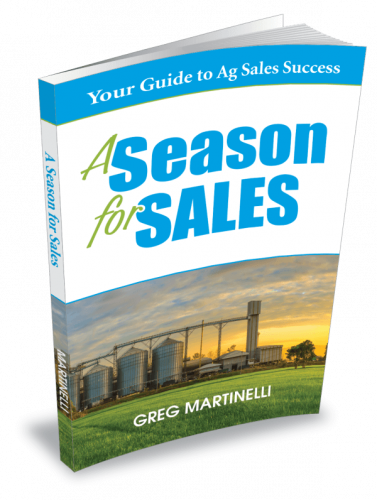You have to be remembered to sell
Your customers are swamped. They are busy, super busy! If they fail to learn about you and your products, they will certainly not remember you when deciding who to buy from. If they currently get a similar product from your competitor, they are heavily inclined to just keep re-ordering from them. It’s called “Pushing the Easy button”. It’s just easier to keep doing what they have been doing.
For example, “Send me 6 tons of my feed” was a very common phone call that our customer service team would receive. No names were exchanged. No product name nor code number. Just a request to send this customer “the usual” order. Our sales coordinators were good enough, they knew the voice and they knew what product to put on order for him.
How then, do we become more memorable to our prospective customers? How do we get them to understand the value of our products? In an ultra-busy world, how do we get a prospect to take the extra time needed to switch from their current supplier to us?
The short answer: Be memorable. Like it or not, you are among a sea of salespeople who call on this producer. How many salespeople are in that sea? For crop producers, it’s dozens. If they raise livestock, add another dozen or more.
Our role as a salesperson is to take all the great information, technology, products, and services that our company produces and transfer it to the customer. That’s a lot of information to transfer. Too often, our natural inclination as a salesperson is to overload the customer with information.
This often involves a lot of written words. This is especially true in highly technical sales or highly complicated products. Follow the diagram below to climb the Ladder of Learning. Take your volume of words and see if you can move them into pictures or videos.
Not all, but most of us struggle to learn by reading the words. Think about your last IKEA project. Without the picture, you probably would not have completed the assembly.
The old assaying, “A picture is worth a thousand words” is true. And as I like to say, “A video is worth a thousand pictures”. It’s estimated that 40% of farmers are active on YouTube. This statistic always stuns salespeople and the marketing departments that I work with. They tell me they have little success getting engagement on their videos. They all want to know what farmers are on YouTube for. Like most of us, I believe farmers are on YouTube to learn how to do complicated tasks.
On a recent bathroom remodel, I was on YouTube at least four different times to learn “How to tile and grout”, and “How to fix plumbing so flushing the toilet doesn’t burn you in the shower”.
A Demo is the next best method of learning for your customers. This is where your prospect gets to try it for themselves on a small scale.
The key is to Demo your difference. Think about your products or services. What makes them different from the competition? Why should this customer buy from you and your company? Look through your marketing material and identify your unique features and benefits. Then, try to determine a way to Demo the Difference.
On a recent window purchase, I had three companies out to the house to bid on the project. Each made claims to have the best, strongest, most energy-efficient windows in the world. Only one of the three did a Demo. He claimed his windows were virtually unbreakable. To demonstrate that, he had a small example of the corner of a vinyl window frame. He offered to give me a free window if I could break it. Needless to say, seven months later, he’s the only one I can remember that showed me the difference in their products. They all had good marketing material. They all had prompt written price quotes. They were all roughly in the same price range. The only difference? A Demo of the Difference. And yes, I ordered from that salesperson. Were the other windows just as strong? Maybe, probably, but I’ll never know.
Another way to Demo your Difference is to use Analogous Learning. An analogous learning strategy can be an extremely effective and memorable experience for people. The more unique the analogy, the easier it is for customers to remember.
For example, in describing the difficulty of balancing the diet for a horse, I could easily have told audiences that the average horse has 100 feet of intestine from nose to tail. And that 70 of those feet are small intestine. And that it’s very easy for those 70 feet to become impacted and cause colic. However, buying a 100-foot rope and laying it out around the room ahead of time allowed me to demo the actual distance of those 100 feet. I did this demo for my adult audiences as well as for my kid’s, “bring your parent to school day”. Recently, some 25 years after I did this rope demo at my daughter’s school, her friends were recalling it. If analogous learning gets a 7-year-olds to remember it for 25 years, I think it will work for customers to remember you.
The last and most effective method in the order of learning is experiencing the real thing. This is most often, a free trial. In the seed world, it might be a few bags of free seed so the customer can plant it and see the results for themselves. In the animal production world, it’s a free trial on a small portion of their livestock. In the computer software world, it’s a free monthly trial. Look at the success rate of Netflix, Apple TV, Hulu, or any subscription type entertainment service. The free trial or the reduced introductory rate is an easy hurdle to get over for most customers. They know you are going to like it once you experience it. Also, they know that you will “hit the easy button” and not cancel. That’s why they take your payment info for the free trial offer.
The free trial is a great selling tool when you have a product that is clearly superior and easy for customers to see. We sold a very palatable feed that livestock just loved. Animal owners equate an animal eating your feed as a sign of quality. Free samples were a great way to show customers proof that we had a great product.
Take a few minutes to review your selling approach and the content of your messages. Try to bump up each message you have in the order of learning depicted above. If you are using a lot of words and statistics to explain how great your products are, please take the time to turn them into pictures, videos, a Demo, or a real experience. Your customers will not only appreciate it but will “get it” and remember it.


